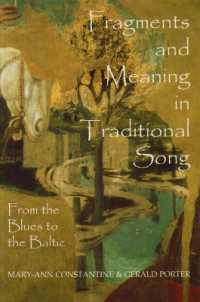Full Description
By providing a variety of strategies, scenarios, student samples, classroom video clips from across all science content areas, rubrics, and guidelines this book provides teachers with the tools to successfully support young scientists to use evidence to construct scientific explanations.With the view that children are capable young scientists, authors encourage science teaching in ways that nurture students' curiosity about how the natural world works including research-based approaches to support all K-5 children constructing scientific explanations via talk and writing. Grounded in NSF-funded research, this book/DVD provides K-5 teachers with a framework for explanation (Claim, Evidence, Reasoning) that they can use to organize everything from planning to instructional strategies and from scaffolds to assessment. Because the framework addresses not only having students learn scientific explanations but also construct them from evidence and evaluate them, it is considered to build upon the new NRC framework for K-12 science education, the national standards, and reform documents in science education, as well as national standards in literacy around argumentation and persuasion, including the Common Core Standards for English Language Arts (Common Core State Standards Initiative, 2010).The chapters guide teachers step by step through presenting the framework for students, identifying opportunities to incorporate scientific explanation into lessons, providing curricular scaffolds (that fade over time) to support all students including ELLs and students with special needs, developing scientific explanation assessment tasks, and using the information from assessment tasks to inform instruction.ABOUT THE VIDEOAll of the video clips associated with this text were filmed in elementary grade classrooms in central, rural Pennsylvania. None of the lessons were staged or scripted. The video was not professionally recorded or produced given that our aim was to be as non-intrusive as possible in the classrooms in which we were guests. Permissions were secured for all students and teachers appearing in the video clips. We hope those that view the videos are as grateful as we are that these teachers were willing to share their attempts to integrate scientific explanation into their science teaching practices, providing us with insights that would not be possible without these images. They are the true heroes of this work. - Carla L. Zembal-Saul, Katherine McNeill, and Kimber Hershberger
Contents
Chapter 1: Importance of Engaging K-5 Students in Scientific Explanation Introduction to engaging K-5 students in scientific explanation Why teach children to construct scientific explanations? Scientific explanations in the classroom Connecting science and literacy through scientific explanation Benefits of engaging students in scientific explanations Understanding science concepts Participating in scientific practices Using evidence to communicate convincingly Learning about the nature of science Benefits of scientific explanation for teachers What to expect in elementary grades Check Point Study Group Questions Chapter 2: Framework for Explanation-Driven Science Framework for explanation-driven science Claim Evidence Reasoning Rebuttal Video Example - Introducing the instructional framework Examples of scientific explanations Life science example Earth science example Physical science example Increasing the complexity of the framework over time Variation #1: Claim and evidence Variation #2: Using multiple pieces evidence Variation #3: Providing reasoning Variation #4: Including a rebuttal Check Point Study Group QuestionsChapter 3: Planning for Explanation-Driven Science Coherent Science content storyline Essential features for constructing scientific explanations Scientific data Scientific principles Learning performances and examples First grade: Sound Second grade: State of matter Third and Fourth grade: Day/night and shadows Fifth grade: Water cycle Complexity of the learning task Openness of the question Characteristics of the data (type and amount) Check Point Study Group QuestionsChapter 4: Integrating Scientific Explanation into Classroom Instruction Instruction sequence for constructing scientific explanations Assessing prior knowledge Framing the question Making predictions Collecting, recording and interpreting data Constructing scientific explanations Instructional strategies for supporting the explanation building process Introducing the framework for explanation Using real world examples to introduce the framework KLEW(S) chart Critique a teacher example Debate a peer example Talk moves for scaffolding the construction of scientific explanations Check Point Study Group QuestionsChapter 5: Designing Assessment Tasks and Rubrics Overview of the development process Step 1: Identify and unpack the content standard Fourth grade writing case - Unpacking Third grade podcast case - Unpacking Step 2: Selecting scientific explanation level of complexity Fourth grade writing case - Level of complexity Third grade podcast case - Level of complexity Step 3: Create learning performances Fourth grade writing case - Learning performance Third grade podcast case - Learning performance Step 4: Write the assessment task Fourth grade writing case - Assessment task Third grade podcast case - Assessment task Step 5: Develop specific rubric Fourth grade writing case - Rubric Third grade podcast case - Rubric Using assessment data to inform instruction Fourth grade writing case - Examples Incomplete evidence and incomplete reasoning Incomplete evidence and complete reasoning Third grade podcast case - Example Assessing informal science talk Check Point Study Group QuestionsChapter 6: Creating a Classroom Community of Young Scientists Norms of participation in science learning Active listening and patterns of talk The role of the scientific explanation framework A culture of constructive criticism Check Point Study Group Questions








